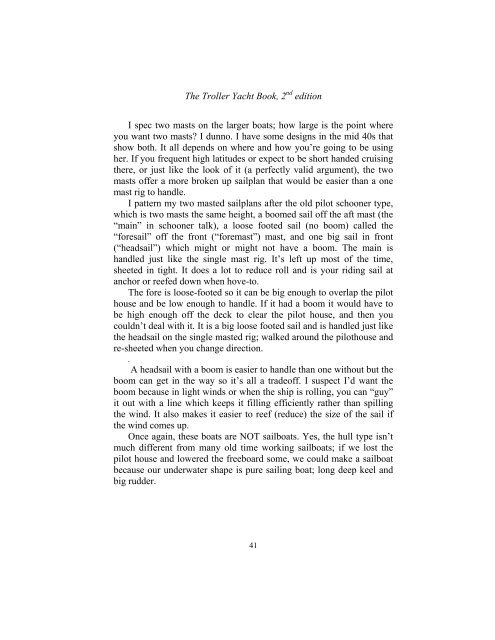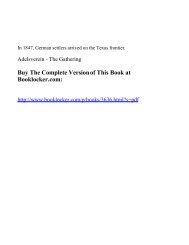The Troller Yacht Book, 2nd Edition - The Book Locker
The Troller Yacht Book, 2nd Edition - The Book Locker
The Troller Yacht Book, 2nd Edition - The Book Locker
You also want an ePaper? Increase the reach of your titles
YUMPU automatically turns print PDFs into web optimized ePapers that Google loves.
<strong>The</strong> <strong>Troller</strong> <strong>Yacht</strong> <strong>Book</strong>, 2 nd edition<br />
I spec two masts on the larger boats; how large is the point where<br />
you want two masts? I dunno. I have some designs in the mid 40s that<br />
show both. It all depends on where and how you’re going to be using<br />
her. If you frequent high latitudes or expect to be short handed cruising<br />
there, or just like the look of it (a perfectly valid argument), the two<br />
masts offer a more broken up sailplan that would be easier than a one<br />
mast rig to handle.<br />
I pattern my two masted sailplans after the old pilot schooner type,<br />
which is two masts the same height, a boomed sail off the aft mast (the<br />
“main” in schooner talk), a loose footed sail (no boom) called the<br />
“foresail” off the front (“foremast”) mast, and one big sail in front<br />
(“headsail”) which might or might not have a boom. <strong>The</strong> main is<br />
handled just like the single mast rig. It’s left up most of the time,<br />
sheeted in tight. It does a lot to reduce roll and is your riding sail at<br />
anchor or reefed down when hove-to.<br />
<strong>The</strong> fore is loose-footed so it can be big enough to overlap the pilot<br />
house and be low enough to handle. If it had a boom it would have to<br />
be high enough off the deck to clear the pilot house, and then you<br />
couldn’t deal with it. It is a big loose footed sail and is handled just like<br />
the headsail on the single masted rig; walked around the pilothouse and<br />
re-sheeted when you change direction.<br />
.<br />
A headsail with a boom is easier to handle than one without but the<br />
boom can get in the way so it’s all a tradeoff. I suspect I’d want the<br />
boom because in light winds or when the ship is rolling, you can “guy”<br />
it out with a line which keeps it filling efficiently rather than spilling<br />
the wind. It also makes it easier to reef (reduce) the size of the sail if<br />
the wind comes up.<br />
Once again, these boats are NOT sailboats. Yes, the hull type isn’t<br />
much different from many old time working sailboats; if we lost the<br />
pilot house and lowered the freeboard some, we could make a sailboat<br />
because our underwater shape is pure sailing boat; long deep keel and<br />
big rudder.<br />
41

















